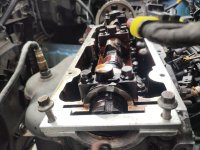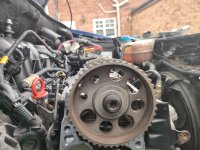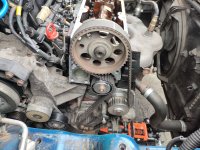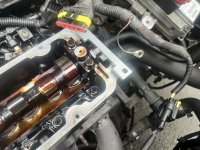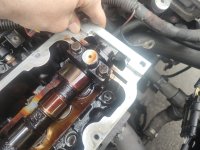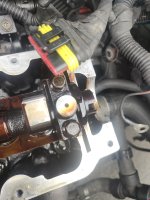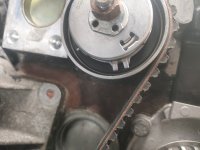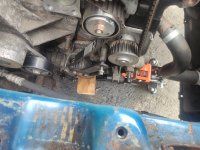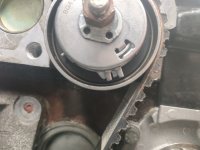Sorry. I should have said, after you've got the camshaft correctly positioned and locked up then turn the crankshaft back to it's locking position with the dumbbell tool. So the crank and cam are both locked up before you try to fit the cam belt. Turn it very gently just in case a piston touches something. I don't think it should but, if something is seriously wrong inside, it might. Of course if it comes into contact with something you've got a serious problem to go looking for.Thanks, that's good to know the plugs are out and that it's a non VVT - still going to have the unkeyed cam pulley though unless I'm very mistaken (which I don't think I am)
I'm finding it just a little difficult to understand some of your description of what exactly you've been doing but you speak of the cam being a quarter turn out with the crankshaft locked up (with the dumbbell tool I guess?) If so the crank and cam are obviously not timed correctly. So, what I would try first would be, with the timing belt removed, set the pistons all half way up/down their strokes. - so all well clear of the cylinder head/valves. feeling for No 1 and No 2 with a screwdriver in their plug holes will confirm this. Then rotate the cam shaft until the cam locking tool can be inserted into the slot on the back end of the cam (you have got the cam cover off haven't you?) this will put both crank shaft and cam shaft "in time" with each other. Of course the valves will move as the cam is rotated but no harm can come to them as the pistons are well down the bores. Now fit the cam belt with the "drive side" (so cam pulley, round the water pump to the crankshaft pulley) as tight as possible. You may actually be one tooth out if you don't remove the crank locking tool and turn the the crankshaft about half a tooth anticlockwise until the tooth drops in. However, even if you're one tooth out you should now have an engine which can be turned by hand quite easily and with minimum resistance. If you put the plugs back in it should run although, if it's one tooth out it won't run particularly well. All the above presuming the main cam retaining bolt hasn't been slackened. If it has then all bets are off as you'll need to do the full timing procedure to get the cam pulley back in time with the crank.
Reading on a bit further it does sound like some quite serious damage was done by the previous owner so there may be other issues we can't possibly know about. Good luck
You are using an out of date browser. It may not display this or other websites correctly.
You should upgrade or use an alternative browser.
You should upgrade or use an alternative browser.
Technical Timing issue
- Thread starter Scottieo321
- Start date
Currently reading:
Technical Timing issue
Scottieo321
Member
Thanks will give the half way method a try on Tuesday and update and I'll also try without slackening retaining bolt.Thanks, that's good to know the plugs are out and that it's a non VVT - still going to have the unkeyed cam pulley though unless I'm very mistaken (which I don't think I am)
I'm finding it just a little difficult to understand some of your description of what exactly you've been doing but you speak of the cam being a quarter turn out with the crankshaft locked up (with the dumbbell tool I guess?) If so the crank and cam are obviously not timed correctly. So, what I would try first would be, with the timing belt removed, set the pistons all half way up/down their strokes. - so all well clear of the cylinder head/valves. feeling for No 1 and No 2 with a screwdriver in their plug holes will confirm this. Then rotate the cam shaft until the cam locking tool can be inserted into the slot on the back end of the cam (you have got the cam cover off haven't you?) Please read the post below at this point as the crankshaft needs to be realigned at this point. This will put both crank shaft and cam shaft "in time" with each other. Of course the valves will move as the cam is rotated but no harm can come to them as the pistons are well down the bores. Now fit the cam belt with the "drive side" (so cam pulley, round the water pump to the crankshaft pulley) as tight as possible. You may actually be one tooth out if you don't remove the crank locking tool and turn the the crankshaft about half a tooth anticlockwise until the tooth drops in. However, even if you're one tooth out you should now have an engine which can be turned by hand quite easily and with minimum resistance. If you put the plugs back in it should run although, if it's one tooth out it won't run particularly well. All the above presuming the main cam retaining bolt hasn't been slackened. If it has then all bets are off as you'll need to do the full timing procedure to get the cam pulley back in time with the crank.
Reading on a bit further it does sound like some quite serious damage was done by the previous owner so there may be other issues we can't possibly know about. Good luck
Yeah it was with the dumbbell looking tool where the cam was around 90 out so deffo been some sort of damage done but to what extent I'll eventually find out.
When I'm next working on it (Tuesday) I'll post some pics or vids to show what I'm doing and if I get stuck what's actually happening, fingers crossed this works and starts, being a tooth out is more easily rectifiable then being completely out.
- Joined
- Apr 22, 2018
- Messages
- 1,009
- Points
- 346
0. Was the engine running before you've messed with it? There is something about bent valves in the middle of page 1...
1. I don't see a "learning" process. You went through Guides/threads = scrolled only (text -> picture -> text -> picture, whatever).
2. If you have timing tools, you don't care about "TDC" much. Who told you to set TDC? Timing tools are intentionally TDC+90 degrees.
3. If you really study the existing content (especially links provided on page 1), there is more than enough quality info to start the engine.
There are ways to confirm "TDC+90" (all pistons on the mid stroke, equal height - it also tells you that crankshaft "key" is not broken).
4. If engine was not running, there is probably more damage already, deeper than bent valve, so swap to brand new one is not enough...
Anyway, good luck. Waiting for an update (what's messed up more: engine or the operator, "mechanic").
1. I don't see a "learning" process. You went through Guides/threads = scrolled only (text -> picture -> text -> picture, whatever).
2. If you have timing tools, you don't care about "TDC" much. Who told you to set TDC? Timing tools are intentionally TDC+90 degrees.
3. If you really study the existing content (especially links provided on page 1), there is more than enough quality info to start the engine.
There are ways to confirm "TDC+90" (all pistons on the mid stroke, equal height - it also tells you that crankshaft "key" is not broken).
4. If engine was not running, there is probably more damage already, deeper than bent valve, so swap to brand new one is not enough...
Anyway, good luck. Waiting for an update (what's messed up more: engine or the operator, "mechanic").
Last edited:
Sounds like I picked a good day to help my daughters with their house moves and not get involved with this.
Generally speaking the Auto Data Timing Belt manual that I used based on the engine Series Data you gave me is what the motortrade uses and is usually accurate and personally I have had no issues with the information in it over many, many years.


Generally speaking the Auto Data Timing Belt manual that I used based on the engine Series Data you gave me is what the motortrade uses and is usually accurate and personally I have had no issues with the information in it over many, many years.
Absolutely Mike. Used it myself in conjunction with the ICME manual when pricing up jobs.Sounds like I picked a good day to help my daughters with their house moves and not get involved with this.
Generally speaking the Auto Data Timing Belt manual that I used based on the engine Series Data you gave me is what the motortrade uses and is usually accurate and personally I have had no issues with the information in it over many, many years.
I'm pretty sure, if i remember correctly, that the crankshaft "dumbbell" locks the crank with pistons all at "half mast"Thanks will give the half way method a try on Tuesday and update and I'll also try without slackening retaining bolt.
Yeah it was with the dumbbell looking tool where the cam was around 90 out so deffo been some sort of damage done but to what extent I'll eventually find out.
When I'm next working on it (Tuesday) I'll post some pics or vids to show what I'm doing and if I get stuck what's actually happening, fingers crossed this works and starts, being a tooth out is more easily rectifiable then being completely out.
Good luck with this going forward and do keep us updated won't you. I can't wait for the outcome, better than a murder mystery book!
Scottieo321
Member
Me I'm messed up more not the engine0. Was the engine running before you've messed with it? There is something about bent valves in the middle of page 1...
1. I don't see a "learning" process. You went through Guides/threads = scrolled only (text -> picture -> text -> picture, whatever).
2. If you have timing tools, you don't care about "TDC" much. Who told you to set TDC? Timing tools are intentionally TDC+90 degrees.
3. If you really study the existing content (especially links provided on page 1), there is more than enough quality info to start the engine.
There are ways to confirm "TDC+90" (all pistons on the mid stroke, equal height - it also tells you that crankshaft "key" is not broken).
4. If engine was not running, there is probably more damage already, deeper than bent valve, so swap to brand new one is not enough...
Anyway, good luck. Waiting for an update (what's messed up more: engine or the operator, "mechanic").
About the learning part I have been this shows it's a learning curve, some of you guys done these plenty so know it off by heart this is my first timing and I've came for help from people who have more knowledge.
I'm guna need all the luck I can get thanks.
Scottieo321
Member
I think I've been using it wrong then, by the guides ect they all say about being TDC which has been in my head all the time but like you've said should all be half mast which makes perfect sense and means I need to have it more round (the dumbbell) as this would be all at half mastI'm pretty sure, if i remember correctly, that the crankshaft "dumbbell" locks the crank with pistons all at "half mast"
Good luck with this going forward and do keep us updated won't you. I can't wait for the outcome, better than a murder mystery book!
I swear if that does the trick and she starts fine and runs albeit a bit sluggish but running I'm guna kick the alloys.
I will be sure to keep you updated if you don't hear from me by Tuesday evening be sure I'm either stuck under the car or driven it down the beach banks
We all have to learn somewhere and no one knows everything.I think I've been using it wrong then, by the guides ect they all say about being TDC which has been in my head all the time but like you've said should all be half mast which makes perfect sense and means I need to have it more round (the dumbbell) as this would be all at half mast.
I swear if that does the trick and she starts fine and runs albeit a bit sluggish but running I'm guna kick the alloys.
I will be sure to keep you updated if you don't hear from me by Tuesday evening be sure I'm either stuck under the car or driven it down the beach banks
In the old days timing was done at TDC (top dead centre) etc. However with the close tolerances these days, for safety reasons they set the timing positions with the pistons lower down the cylinder bores to reduce the chance of pistons hitting the valves when setting the timing.
The timing when set up correctly is still like the old days, but you have to follow the manual instructions and use the special tools exactly as the book .
Providing that is done and afterwards the engine is turned over by hand at least two full revolutions and there is no metal to metal contact, then at least if you get it wrong even if it doesn't start, there should be no physical damage. Always assuming there was no damage previously. You mentioned a tapping noise and low power etc. which isn't a good sign?
The first version of this FIRE engine, which had marks on both cam and crankshaft pulleys and corresponding marks on the engine casings was timed at TDC. That is to say, when the crankshaft pulley mark lined up with the mark on the oil pump casting then No1 and No4 were at TDC. This all changed when the unkeyed cam pulley was introduced.Me I'm messed up more not the engine. Engine running before but lack of power, tapping noise from engine (assuming valves) car couldn't get up slight incline without being in 2nd/3rd plus high fuel consumption. See the guides say to make sure it's at TDC which is what I've been going off saying piston/cylinder 1 needs to be at top point.
About the learning part I have been this shows it's a learning curve, some of you guys done these plenty so know it off by heart this is my first timing and I've came for help from people who have more knowledge.
I'm guna need all the luck I can get thanks.
Just to let you know I wish you all the luck I can!
Scottieo321
Member
So bit of an update, done all that has been told, when doing the first 2 turns with full tension it all stayed the same albeit a tooth out on the cam side weirdly ( would need 1 tooth in forward direction for it to allow the tool in easily.
Done 4/5 more turns with forks on tension being aligned but now the forks have moved.
I'll post pics of everything to now.
First lot are before putting belt on
Next post will be after and then where I'm currently up to.
You'll also see in a set where oil is coming out from is this normal?
Done 4/5 more turns with forks on tension being aligned but now the forks have moved.
I'll post pics of everything to now.
First lot are before putting belt on
Next post will be after and then where I'm currently up to.
You'll also see in a set where oil is coming out from is this normal?
Attachments
Scottieo321
Member
Scottieo321
Member
Scottieo321
Member
Done another 2 turns and it's staying in that same position, is it worth just moving the tension forks again?
I can't see from the picture of the dumbbell whether you've got the little "pip" in the little hole of the dumbbell? I guess you have? The cam locking tool looks engaged correctly.So bit of an update, done all that has been told, when doing the first 2 turns with full tension it all stayed the same albeit a tooth out on the cam side weirdly ( would need 1 tooth in forward direction for it to allow the tool in easily.
Done 4/5 more turns with forks on tension being aligned but now the forks have moved.
I'll post pics of everything to now.
First lot are before putting belt on
Next post will be after and then where I'm currently up to.
You'll also see in a set where oil is coming out from is this normal?
Did you slacken the big Torx bolt in the middle of the cam pulley at any time? If not then it's all looking good. I'm asking about this because that's what's giving you the "problem" with the "one tooth out" You probably need to slacken the tensioner again and turn the crankshaft anticlockwise just enough to allow the belt to be positioned one tooth back on the cam pulley. When you then take up the slack by turning the crank slightly clockwise and retighten the tensioner you should find that with the crankshaft "dumbbell fitted then the cam locking tool will just "fall" into it's slot.
The tensioner question is a little more difficult. When you first fit a new belt you are supposed to "overtighten" the tensioner by rotating it until all the spring movement is used up. Then rotate the crank a turn or two to fully settle the belt and finish by backing off the tensioner until the fork marks line up. Because of this "stretching effect" on the new belt many say it's only possible to correctly tension a new belt once. Which means they are advising a belt can only be tensioned once! Ok, if that's the "official" advice then who an I to doubt it. However I have refitted "used but good" belts when doing head jobs etc and never had a problem. (Always mark DOR with an arrow if you're intending to refit a belt) Myself? If the tensioner fork doesn't line up after I'd done the initial crankshaft turns by hand, I'd be readjusting it until it does. I've noticed when rechecking a new belt after maybe a couple of thousand miles, that the forks are always just slightly displaced. And, more interestingly perhaps? the fork positions vary slightly depending on whether the engine is cold or fully up to operating temperature - Which, to my mind is entirely logical as the crankshaft and camshaft pulleys will be very very slightly further apart when the engine is hot due to expansion of the block and head. Looking at the tensioner of a belt which has a lot of miles on it never has the forks lining up exactly. So I'd say that having the forks lined up exactly is the ideal position but the spring allows for taking up the tension anyway when running and as the belt ages so being just a wee bit out is of little consequence. It just makes sense to line it up as near to perfect when fitting though, doesn't it?
Don't worry about oil coming out of that wee hole centre front of the head. That's the oil feed to the cam cover which takes oil up to the camshaft bearings via oilways in the cam cover. If you turn the crankshaft it's also turning the oil pump so if you turn it more than just a couple of turns then oil will come out of it. I once turned one of these with the cam cover off using the starter motor after fitting a cam belt - thinking that letting it spin over for a couple of dozen revs would let me see how the belt was settling into running on the pulleys - this resulted in an absolute fountain of oil comming out of that hole and dribbling down the front of the engine - hell of a mess and I won't do it again! By the way, when you come to finally fitting the cam cover make sure the groove the gasket fits into is clean and, especially at the corners, use a little sealant or it will leak.
Last edited:
Scottieo321
Member
Yeah it's in the pip (snapped off when I took the big one off but still has it's marking so know where it goes) you were absolutely correct needing the engine pistons at half mass (started up a few teeth out straight away albeit misfiring and wobbling like mad, only ran it 3 seconds at most).I can't see from the picture of the dumbbell whether you've got the little "pip" in the little hole of the dumbbell? I guess you have? The cam locking tool looks engaged correctly.
Did you slacken the big Torx bolt in the middle of the cam pulley at any time? If not then it's all looking good. I'm asking about this because that's what's giving you the "problem" with the "one tooth out" You probably need to slacken the tensioner again and turn the crankshaft anticlockwise just enough to allow the belt to be positioned one tooth back on the cam pulley. When you then take up the slack by turning the crank slightly clockwise and retighten the tensioner you should find that with the crankshaft "dumbbell fitted then the cam locking tool will just "fall" into it's slot.
The tensioner question is a little more difficult. When you first fit a new belt you are supposed to "overtighten" the tensioner by rotating it until all the spring movement is used up. Then rotate the crank a turn or two to fully settle the belt and finish by backing off the tensioner until the fork marks line up. Because of this "stretching effect" on the new belt many say it's only possible to correctly tension a new belt once. Which means they are advising a belt can only be tensioned once! Ok, if that's the "official" advice then who an I to doubt it. However I have refitted "used but good" belts when doing head jobs etc and never had a problem. (Always mark DOR with an arrow if you're intending to refit a belt) Myself? If the tensioner fork doesn't line up after I'd done the initial crankshaft turns by hand, I'd be readjusting it until it does. I've noticed when rechecking a new belt after maybe a couple of thousand miles, that the forks are always just slightly displaced. And, more interestingly perhaps? the fork positions vary slightly depending on whether the engine is cold or fully up to operating temperature - Which, to my mind is entirely logical as the crankshaft and camshaft pulleys will be very very slightly further apart when the engine is hot due to expansion of the block and head. Looking at the tensioner of a belt which has a lot of miles on it never has the forks lining up exactly. So I'd say that having the forks lined up exactly is the ideal position but the spring allows for taking up the tension anyway when running and as the belt ages so being just a wee bit out is of little consequence. It just makes sense to line it up as near to perfect when fitting though, doesn't it?
Don't worry about oil coming out of that wee hole centre front of the head. That's the oil feed to the cam cover which takes oil up to the camshaft bearings via oilways in the cam cover. If you turn the crankshaft it's also turning the oil pump so if you turn it more than just a couple of turns then oil will come out of it. I once turned one of these with the cam cover off using the starter motor after fitting a cam belt - thinking that letting it spin over for a couple of dozen revs would let me see how the belt was settling into running on the pulleys - this resulted in an absolute fountain of oil comming out of that hole and dribbling down the front of the engine - hell of a mess and I won't do it again! By the way, when you come to finally fitting the cam cover make sure the groove the gasket fits into is clean and, especially at the corners, use a little sealant or it will leak.
No didn't slaken it this time kept it firmly in place, guna turn it back to allow all to firmly fall into place.
Oh no don't say that, I've gone through 4 doing this thinking it could only be used / tensioned once
Like yourself id be under the same assumption as the belt running for even a minute will cause friction which inturn heats or warms the belt and the tensioner allowing movement where needed.
The oil bit however I'm glad is fine and I remember seeing a post from yourself on another thread saying you made that mistake
Going to put everything perfectly in place and will update and I'm right in saying let the engine run for 5 or so mins no peddle pressing for it to relearn? So long as everything else goes to plan that is.
I guess you're talking about whether the ecu needs to relearn the cam and crank sensor signals with the new belt fitted? Fiat call this a "Phonic Wheel Relearn" (the Phonic Wheel is the toothed auxiliary belt pulley on the crankshaft). It seems to be absolutely pot luck whether you'll find a problem with that. If it's going to be needed you'll usually find the check engine light will come on the first time you take it out for a "proper" drive (ie. not just round the block) If the light comes on for this reason, when you scan it for codes you'll find a miss fire code stored but it's just that that is the nearest code to describe what it's seeing - You won't notice any misfire symptoms like uneven tickover or rough running etc because it's not a miss fire! To reset you'll need MES - which many of us have so look in the MultiEcuScan thread for people who can help. If you go to the main dealer it'll cost and you can't reset it without a proper scanner like MES. I've found that if you don't disturb the cam pulley - so don't slacken the cam pulley bolt - then they often don't need a Phonic Wheel Relearn. If the light doesn't come on after you've been out for a good run in her then a relearn is unlikely to be needed.Going to put everything perfectly in place and will update and I'm right in saying let the engine run for 5 or so mins no peddle pressing for it to relearn? So long as everything else goes to plan that is.
To do a phonic wheel relearn see this video. Its a Fiat 500 but the same engine that you have and the same procedure. You'll need MultiECUscan, which you'll need to pay a one off fee for, and the correct cables, be careful buying those because Fiat have 'special cables'. Hopefully it won't need a relearn.
Last edited:
- Joined
- Apr 22, 2018
- Messages
- 1,009
- Points
- 346
Did you checked if the pistons are mid stroke (equal) or not (when timing tools are installed)? That was the main point here.
Timing looks OK (but we/you don't know where the pistons really are).
Official eLearn procedure is wrong: they tell you to tension the belt (max.), then back off (until "forks" aligned) = it will shift the timing.
This is natural. But such small shift will not cause any trouble (engine must start). So this is not a problem at all. Belts don't "stretch" (that's BS).
Same with "phonic wheel reset/adaptation/whatever". It is one of the most useless features in the FES/MES programs.
It does almost nothing (cosmetic changes). It has nothing to do with the engine starting (or not). So forget about it for now.
Clueless people are fixated, obsessed with it (forums are full of "advice" like that: have you done The Reset, do the reset, you must do the reset, your car needs a phonic wheel procedure, learning, reset,...crazy). Engine won't start = phonic wheel reset. Rough idle = phonic wheel reset. Misfire = reset...
Timing looks OK (but we/you don't know where the pistons really are).
Official eLearn procedure is wrong: they tell you to tension the belt (max.), then back off (until "forks" aligned) = it will shift the timing.
This is natural. But such small shift will not cause any trouble (engine must start). So this is not a problem at all. Belts don't "stretch" (that's BS).
Same with "phonic wheel reset/adaptation/whatever". It is one of the most useless features in the FES/MES programs.
It does almost nothing (cosmetic changes). It has nothing to do with the engine starting (or not). So forget about it for now.
Clueless people are fixated, obsessed with it (forums are full of "advice" like that: have you done The Reset, do the reset, you must do the reset, your car needs a phonic wheel procedure, learning, reset,...crazy). Engine won't start = phonic wheel reset. Rough idle = phonic wheel reset. Misfire = reset...
Last edited:
Mike1alike
Established member
Are you ok, @GrandePunto PL? Is there something that's making your life bitter?
You are right in what you're saying, but it looks like you're putting a lot of... emphasis into it. Can we help?
You are right in what you're saying, but it looks like you're putting a lot of... emphasis into it. Can we help?
Similar threads
- Replies
- 15
- Views
- 649




